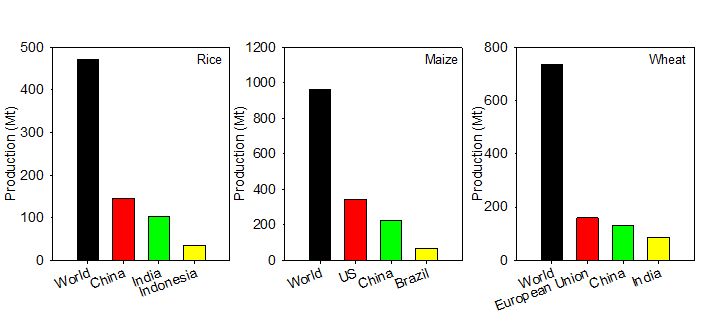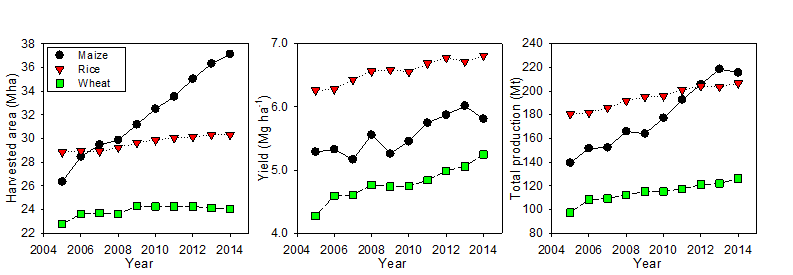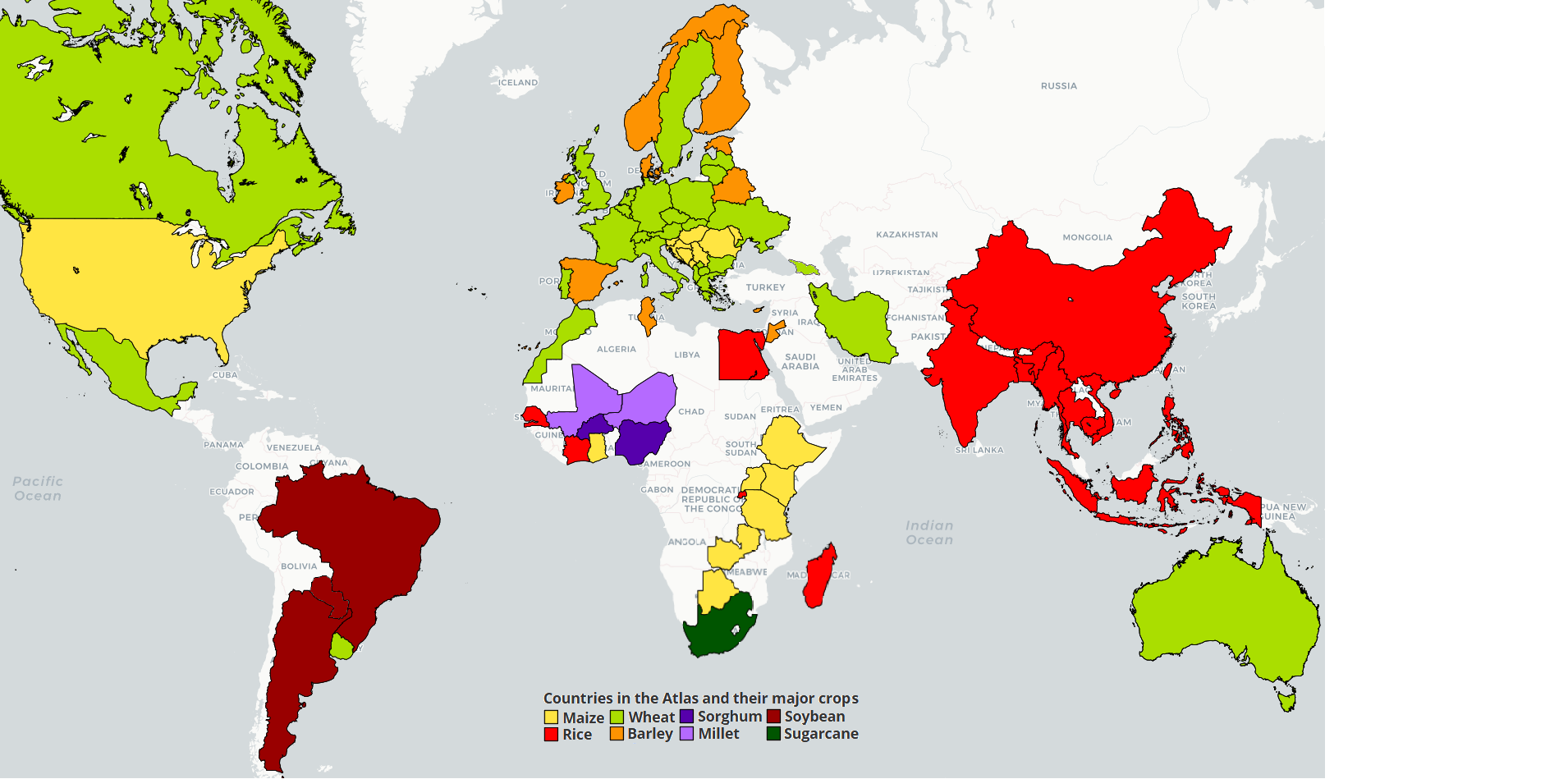 China
China
Detailed information on the analysis by crop is available for:
- Rice. Please check the China rice page
- Maize. Please check the China maize page
- Wheat. Please check the China wheat page
- Soybean. Please check the China soybean page
- Potato. Please check the China potato page
- Cotton. Please check the China cotton page
Descriptions of major crop systems, climate, topography, and soils
Agriculture is vitally important for China. China feeds 1.3 billion of people, or 19% of the world population, with only 7% percent of the planet's arable land, with about 75% of China's cultivated area is used for food crops (FAOSTAT, 2014). Rice, maize and wheat are the three major crops, and the production of these three crops accounts for more than 90% of China's total food production. In China, around 80% of crop production is allocated to human food, while 20% to animal feed (Kearney, 2010; Foley et al., 2011). With the rapid urbanization and growth of people's income and change of life style, the diet of Chinese people are changing from high carbohydrate foods to high protein and energy-dense foods, resulting in more demand for animal products (mainly pork and poultry), therefore more crop productions (Du et al., 2004; Zhai et al., 2014). This situation is in turn putting more pressure on agriculture. In total, China will need 776 Mt grain by 2030 to feed its own people, representing an increase of 36% from the food production in 2014 (Li et al., 2014). Hence, further increase and sustaining of food production has become a national priority.
Major crop systems
Rice
China is one of the largest rice producing and consuming countries, accounting for more than 40% of global rice production (Figure 1) and more than 30% of global rice consumption. Rice harvest area in China's accounts for about 25% of the county's cultivated area (FAOSTAT, 2014). Irrigated rice dominates in China, accounting for more than 99% of total rice harvested area (You et al., 2014). Between the two major types of rice, Indica rice accounts for three-quarters of the rice area while the remaining is Japonica rice. Indica rice varieties are generally grown in the south and Japonicas in the north. Hybrid rice varieties occupy about 50% of China's rice harvested area (Yuan, 2003). In south China, two to three rice crops can be grown within one year, whereas in north China only a single-season rice is grown.
The major problems confronting rice production in China are the narrow genetic background, overuse of fertilizers and pesticides, breakdown of irrigation infrastructure, oversimplified crop management, and a weak extension system (Peng et al., 2009). On the other hand, many studies have reported that rice yield has reached its plateau and remained unchanged for several years in China (Zhang et al., 2014; Wei et al., 2015; Xu et al., 2016), implying a small or even negligible yield gain in the near future in China. Therefore, alleviating yield stagnation and further raising rice production is vitally important to ensure food security in China.
Maize
Maize accounts for more than one-third of China's cereal production (Figure 2) and is responsible for 23% of the global maize output (FAO, 2012, Figure 1). Maize is grown in north and northeast China. Until the mid-1990s, China's maize grain yield increased in a near-linear fashion, but has stagnated at around 5 Mg ha-1 since 1995. Average annual growth rates declined from 5-8% in 1960-1980s to <1% in the past 20 years. In particular, the focus of China's demand for grains has shifted from staple grains including rice and wheat to maize, which is used primarily as animal feed (Meng et al., 2013).
Wheat
Since 1991, China has been one of the top wheat producer in the world (Figure 1). A tremendous progress has been achieved in China's wheat production with average yields increased from less than 1 t ha-1 in 1949 to 5 t ha-1 in 2013, and a total production of 126 Mt in 2014 (Qin et al., 2015). The wheat-growing regions of China are divided into three major agro-ecological zones: northern China winter wheat region, southern China winter wheat region, and southern China spring wheat region. The northern winter wheat region is the most important wheat-producing area, with 60 to 70% of the total wheat production in China, followed by the southern winter wheat region with 25% (He, 2001).

Figure 1 Food (either rice, maize or wheat)production in the world and top three producing countries in the year 2015 (Source from USDA, http://apps.fas.usda.gov/psdonline/).

Figure 2 Tendency of harvested area, average yield, and total production of rice, maize and wheat in China. (Source from National Bureau of Statistics of China, http://www.stats.gov.cn/)
Climate, topography and soil
China has diverse topography, soil and climatic conditions. The entire country can be divided into nine major agricultural zones (Source from FAO, http://www.fao.org/ag/agp/agpc/doc/counprof/china/china1.htm):
The Northeast
As a vast plain, this zone has fertile land for agriculture and forest and plenty of water, but a relatively shorter duration of the growing season. Industry and communications are developed, and agriculture scale is large, but the population engaged in agriculture is low. It is the most important production base for cereals, soybean and sugar beet.
Inner Mongolia and Along the Great Wall
With a temperate climate, low precipitation and shortage of water, there is less arable and forest, but vast grasslands. The agricultural environment is very vulnerable because of frequent drought, windy weather and increasing desertification. The main agricultural sector is livestock, and crop and animal husbandry are mixed.
Yellow River, Huai River and Hai River
The climate is temperate monsoon with simultaneous rainfall and solar radiation. Water is relatively scarce. With vast plains, well-equipped agricultural machinery, good communications, a long history of cultivation and a high proportion of arable land, it is an important base for wheat, cotton, maize, groundnuts and fruits.
Loess Plateau
The topography is characterized by plateau and hills covered by loess; soil erosion is very severe. Solar radiation is plentiful, but water scarce. Agricultural structure is unitary with rainfed grain production. The commodity economy is weakly developed, however the potential for developing grassland farming and fruit culture is high.
Middle and Lower Reaches of Yangtze River
Solar radiation, temperatures and water are all favorable. The arable area is large and fertile. City density is quite high and industry is well developed. Agriculture is highly developed with a high total yield of agricultural products and a high commodity rate. It is the main integrated agricultural production area and the base for rice, cotton, oil crop, tea, silk, pigs and fish.
The Southwest
The climate is warm and humid. The terrain is dominated by hills, with little flat land. There is plenty of biodiversity and rare species. Agriculture is poor with extensive systems and low productivity. Grain production is for subsistence.
South China
The topography is characterized by hills, scarce arable land and a long coastline. Most of the area is subtropical with plenty of precipitation; it is the only area suitable for tropical crops.
Gansu and Xinjiang
Land resources are typified by vast areas and low quality; there is much natural grassland but little forest and arable. Solar radiation and thermal resources are abundant, but water is very scarce. Desertification and salinization are very severe and the agricultural environment is very fragile. Grain and oil resources per capita are high. The yield of cotton, sugar beet, fruit and melon is high. Grassland husbandry is well developed.
Qinghai-Tibet
This zone is characterized by rarefied air, high altitude, strong solar radiation and low temperatures. The area of natural grassland takes first place and forest takes second. Arable land is very rare and distributed in patches. Water is plentiful but unevenly distributed. The management of agriculture and animal production is extensive and production level is low.
References
Du, S., Mroz, T.A., Zhai, F., Popkin, B.M., 2004. Rapid income growth adversely affects diet quality in China - particularly for the poor! Social science & medicine 59, 1505-1515.
Duan, J., Zhou, G., 2012. Climatic suitability of single cropping rice planting region in China.Chinese Journal of Applied Ecology 23, 426-432.
Duan, J., Zhou, G., 2013. Dynamics of decadal changes in the distribution of double-cropping rice cultivation in Chinese Science Bulletin 58, 1955-1963.
FAOSTAT, 2014. Asia and Pacific agriculture.
Foley, J.A., Ramankutty, N., Brauman, K.A., Cassidy, E.S., Gerber, J.S., Johnston, M., Mueller, N.D., O/'Connell, C., Ray, D.K., West, P.C., Balzer, C., Bennett, E.M., Carpenter, S.R., Hill, J., Monfreda, C., Polasky, S., Rockstrom, J., Sheehan, J., Siebert, S., Tilman, D., Zaks, D.P.M., 2011. Solutions for a cultivated planet. Nature 478, 337-342.
Grassini, P., van Bussel, L.G.J., Van Wart, J., Wolf, J., Claessens, L., Yang, H.S., Boogaard, H., de Groot, H., van Ittersum, M.K., Cassman, K.G., 2015. How good is good enough? Data requirements for reliable crop yield simulations and yield-gap analysis. Field Crops Research 177, 49-63.
He, Z., 2001. A history of wheat breeding in China. Cimmyt.
Kearney, J., 2010. Food consumption trends and drivers. Philosophical Transactions of the Royal Society of London B: Biological Sciences 365, 2793-2807.
Li, Y., Zhang, W., Ma, L., Wu, L., Shen, J., Davies, W.J., Oenema, O., Zhang, F., Dou, Z., 2014. An analysis of China's grain production: looking back and looking forward. Food and Energy Security 3, 19-32.
Meng, Q., Hou, P., Wu, L., Chen, X., Cui, Z., Zhang, F., 2013. Understanding production potentials and yield gaps in intensive maize production in China. Field Crops Research 143, 91-97.
Peng, S., Tang, Q., Zou, Y., 2009. Current status and challenges of rice production in China. Plant Production Science 12, 1-6.
Qin, X., Zhang, F., Liu, C., Yu, H., Cao, B., Tian, S., Liao, Y., Siddique, K.H.M., 2015. Wheat yield improvements in China: Past trends and future directions. Field Crops Research 177, 117-124.
van Bussel, L.G.J., Grassini, P., Van Wart, J., Wolf, J., Claessens, L., Yang, H.S., Boogaard, H., de Groot, H., Saito, K., Cassman, K.G., van Ittersum, M.K., 2015. From field to atlas: Upscaling of location-specific yield gap estimates. Field Crops Research 177, 98-108.
Wei, X., Zhang, Z., Shi, P., Wang, P., Chen, Y., Song, X., Tao, F., 2015. Is Yield Increase Sufficient to Achieve Food Security in China? Plos One 10, e0116430.
Xu, X., He, P., Zhao, S., Qiu, S., Johnston, A.M., Zhou, W., 2016. Quantification of yield gap and nutrient use efficiency of irrigated rice in China. Field Crops Research 186, 58-65.
You, L., U. Wood-Sichra, S. Fritz, Z. Guo, L. See, and J. Koo. 2014. Spatial Production Allocation Model (SPAM) 2005 v2.0. Available from http://mapspam.info.
Yuan, L., Virmani, S., Mao, C., Hardy, B., 2003. Recent progress in breeding super hybrid rice in China. Hybrid rice for food security, poverty alleviation and environmental protection. Proceedings of the 4th International Symposium on Hybrid Rice, Hanoi, Vietnam, 14-17 May, 2002. International Rice Research Institute (IRRI), pp. 3-6.
Zhai, F.Y., Du, S.F., Wang, Z.H., Zhang, J.G., Du, W.W., Popkin, B.M., 2014. Dynamics of the Chinese diet and the role of urbanicity, 1991–2011. Obesity Reviews 15, 16-26.
Zhang, T.Y., Yang, X.G., Wang, H.S., Li, Y., Ye, Q., 2014. Climatic and technological ceilings for Chinese rice stagnation based on yield gaps and yield trend pattern analysis. Global Change Biology 20, 1289-1298.
Get access to the Atlas for advanced users
Download GYGA results
 | Please read the license information in case you are interested in using the data from the Global Yield Gap Atlas. |
| read more>> |
 Country agronomists
Country agronomists

Shaobing Peng

Nanyan Deng

Na Wang

Baohua Liu

